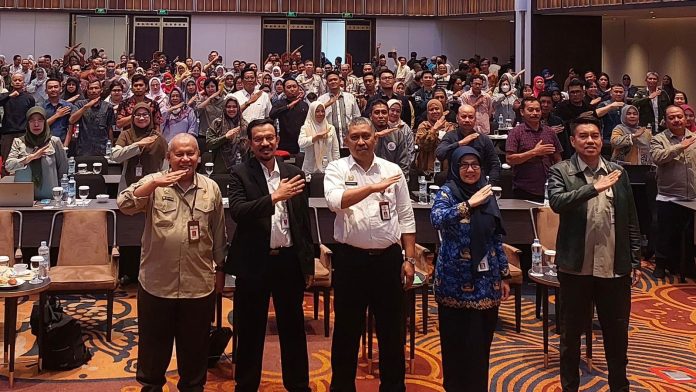TANGERANG – The Directorate General of Horticulture held a workshop on Strengthening the PAGU RKAKL for Fiscal Year 2024.
This activity, which took place on 2–4 October 2023, was attended by the Agriculture Services of 34 provinces to synergize central and regional programs.
Not only did it determine major horticultural activities, it also designed technical activities by implementing implementation guidelines based on budget availability.
“It is hoped that the implementation of the 2024 activity program will be more stable. The planning dynamics are always updated according to conditions,” said Secretary of the Directorate General of Horticulture Muhammad Taufiq Ratule when opening the event on Monday (2/10).
“As we know, planning is an important management activity to determine output. With good planning, we are able to minimize failure because it functions as a locomotive.
“If planning is carried out well, it means that 50 percent of the work has been completed. Planning determines the achievements of an organization, which means it must be well implemented,” he explained.
What will be different in 2024, continued Taufiq, is that seed activities consisting of seeds and inputs will be attached to the technical directorate.
The cost of the main components of 93-94 percent comes from the total budget per detailed output (RO) and supporting cost components to the total output costs of infrastructure goods of 6 percent.
The limit on the amount of supporting costs on the total output costs of non-infrastructure goods is 7 percent.
“In 2024, production of several strategic commodities is targeted to increase. Among them, chilies are targeted to reach 3 million tonnes in 2023, shallots 1.74 million tonnes, garlic 45.91 thousand tonnes, potatoes 1.41 million tonnes, bananas 8.93 million tonnes, mangosteen 288.4 thousand tonnes, durian 1.36 million tonnes, orchids 21.4 million stalks, chrysanthemums 441 million stalks, and ginger 209 thousand tonnes,” explained Taufiq.
The implementation of vegetable villages, which in 2023 will complete 1,704 villages, is targeted to increase in 2024 to 2,180 villages.
For fruit villages, by 2024 the target is 527 villages. Meanwhile, in 2023 there will be 678 villages.
Taufiq explained that by 2024 it is hoped that they will be able to minimize repeated findings related to OPT control where OPT gerdal control is not yet in season, gerdal materials have not been used, and the use of IPM clinic equipment has not been optimized.
Meanwhile, for the distribution of seeds and inputs, there is a mismatch in the distribution of seeds and inputs.
On the other hand, the growth of MSMEs related to assistance with MSME facilities and infrastructure has not been on target, the use of tools has not been optimal, and MSME activities have not developed.
Meanwhile, for the provision of seeds, there are mother trees that are not maintained and production targets are not achieved. This results in low productivity for chilies, shallots and garlic.
Reflecting on the 2023 evaluation, the Director of Vegetables and Medicinal Plants Andi Muhammad Idil Fitri said that the priority for developing chilies and onions focuses on minus areas and contributors to inflation as well as supply buffer areas.
Apart from that, we also continue to develop local garlic and develop medicinal plants for partnerships and exports. Including the development of fruit vegetables, leaf vegetables and medicinal plants in swamp and peat lands.
“Backyard vegetables (P2L) and large-scale STO areas (Food Estate) are included in our programs next year,” said Idil.
“Supporting infrastructure facilities such as nurseries, mushroom huts, and hydroponics and especially vegetable villages.
“Specifically for this vegetable and medicinal plant village, we have the SRIKANDI app which makes it easy to carry out monitoring and evaluation, one of which is that the village has a village information board that is being developed,” he explained.
Director of Fruit and Floriculture Liferdi Lukman said that strategic fruit and floriculture activities were developed in the form of registered fruit and floriculture villages in order to create One Village One Variety.
Supervision regarding this development will be carried out intensively from upstream to downstream, including facilitating access to support for capital (KUR), agricultural mechanization, and irrigation.
“Our target is to fulfill the need for domestic fresh and processed products, increase exports of fruit and floriculture products, substitute imports for fruit and floriculture products, as well as develop agrotourism and agro-edutourism,” explained Liferdi.
Meanwhile, Director of Horticultural Protection Jekvy Hendra said that his party’s activities in 2024 will consist of developing OPT gerdals, Integrated Pest Management Trained Farmer Groups (KTPHT), handling the impacts of climate change, and establishing IPM clinics.
From the downstream side, the focus of the Directorate for Processing and Marketing of Horticultural Products says that there will be 445 horticultural SMEs by 2023.
These SMEs will be prepared to enter the export market through assistance with GAP, GHP, HCCAP certification and halal certification.
“Apart from that, we will develop SMEs into SMIs, provide assistance in terms of financing, and technical management and technology guidance,” concluded the PPHH Director, Bambang Sugiharto.




